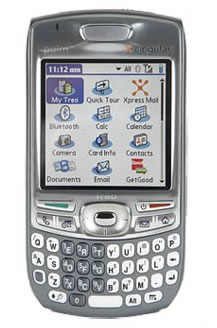Palm Treo 680
 It has been a big year for smart phones with the launch of some highly anticipated devices, such as the T-Mobile Dash, the RIM BlackBerry Pearl, and the Samsung BlackJack. And while the new products and their manufacturers have done a lot to mix up the current lineup of smart phones, the Palm Treo remains one of the most popular and prevalent convergence devices on the market. And now, with the release of the consumer-friendly and more affordable Palm Treo 680 for Cingular Wireless, we think there's a good chance even more Treos will find their way into the hands of gadget lovers.
It has been a big year for smart phones with the launch of some highly anticipated devices, such as the T-Mobile Dash, the RIM BlackBerry Pearl, and the Samsung BlackJack. And while the new products and their manufacturers have done a lot to mix up the current lineup of smart phones, the Palm Treo remains one of the most popular and prevalent convergence devices on the market. And now, with the release of the consumer-friendly and more affordable Palm Treo 680 for Cingular Wireless, we think there's a good chance even more Treos will find their way into the hands of gadget lovers.
When Palm first announced the Treo 680 back in October, the tech press (present company included) reacted with skepticism over the new device's lackluster features. Though Palm touted it as a "low-cost" device, we had no idea what that meant as the company didn't reveal a price point. But now that all the details are out and we've had a chance to play with the device, we're changing our tune a bit. First, it's important to remember that the Treo 680 is a smart phone aimed at a mass audience; it's not for the power business user who would be better off with the Cingular 8525 or the Nokia E62. The 680 offers solid performance and features e-mail capabilities, integrated Bluetooth, and the intuitive Palm OS. We still don't forgive Palm for equipping the 680 with a lowly VGA camera, especially when many basic camera phones have at least a megapixel lens. That aside, it's a good choice for someone who's looking to purchase his or her first smart phone or simply wants to be more productive on the go.
The Palm Treo 680 is available from Cingular starting November 24, for a reasonable $199.99 with a two-year contract and an unlimited data plan. However, only the graphite version will be offered by the carrier. If you fancy the crimson, copper, or arctic models or don't want to be tied down to Cingular, Palm will offer unlocked versions of all four Treo 680 models for $399, available for preorder now.
DesignThe Palm Treo 680 went under the knife to slim down a bit, but it's only marginally smaller (4.4x2.3x0.8 inches; 5.5 ounces) than the Treo 700p/700w (4.4x2.3x0.9 inches; 6.4 ounces). The 680 is noticeably lighter, however, and it felt more comfortable to hold with its curved and tapered edges. You'll also notice that stubby external antenna is gone in favor of a more streamlined and sleek device. It still makes for a bit of a tight fit in a pants pocket, but no more than any other smart phone with a touch screen, such as the Cingular 8525.
The Palm Treo 680 gets rid of the stubby antenna found on previous models such as the Treo 700p.
The Treo 680 retains the same, sharp 2.5-inch diagonal touch screen with a 64,000-color output and 320x320-pixel resolution. Images and Web pages are vibrant, and text is sharp and easily readable. In addition, we still were able to read the display in direct sunlight. The ability to enter data and operate the device via the touch screen is certainly an advantage it has over some of the other popular, sleeker smart phones out there--the Motorola Q, for example. While the Treo 680 is easy to navigate one-handed with the external controls, the touch screen is incredibly convenient and useful.
Looking good. The Treo 680 boasts a colorful and sharp touch screen.
Below the display, you'll find the same set of navigation controls found on the most recent Treos. There are talk and end keys, a four-way directional keypad with a center select button, and shortcuts to the phone app, calendar, messages, and home page. You can reprogram any of the last four buttons to open up different apps. Furthermore, pressing the option key and then one of the said keys launches four more user-defined programs, so in effect, you get a total of eight shortcut keys.
The Treo 680's QWERTY keyboard is largely unchanged from the Treo 700p, but there are some very slight tweaks. The shape of the buttons is more rectangular, and they're not as raised above the phone surface. Though they're tactile and well backlit, the spacing between the keys is fairly cramped, so much so that even our smaller hands had a hard time pressing the right keys. It slowed down the messaging process, but we did get the hang of it eventually. We found having nails helps, but customers with larger digits should definitely take it out for a test drive. This is one area where the Moto Q and the Samsung BlackJack with their more spacious keyboards have the Treo beat.
Read more at Cnet
No comments:
Post a Comment